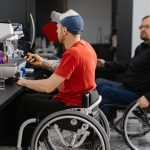Imagine dictation technology as your own personal assistant, ready to transcribe your thoughts and words effortlessly.
Dictation technology has come a long way, and its impact on improving mobility is undeniable. From helping individuals with physical disabilities to streamlining everyday tasks, the potential of dictation technology is boundless.
But how exactly does it work, and what are the latest advancements in this field? Keep on reading to discover how dictation technology is shaping the way we interact with our devices and the world around us.
Key Takeaways
- Dictation technology revolutionizes communication for individuals with mobility challenges.
- Advances in artificial intelligence and machine learning improve the accuracy of dictation technology.
- Dictation allows for faster documentation without typing, enhancing productivity and efficiency.
- Voice-activated devices and appliances offer hands-free control, promoting accessibility and convenience.
The Evolution of Dictation Technology
Over the years, dictation technology has evolved significantly, revolutionizing the way people interact with devices and improving accessibility for individuals with mobility challenges. Voice recognition and speech to text technology have played a pivotal role in this evolution.
Initially, voice recognition was limited and often struggled to accurately transcribe spoken words. However, with advancements in artificial intelligence and machine learning, speech to text technology has become remarkably accurate and seamless.
Voice recognition technology has transitioned from basic command execution to understanding natural language with all its nuances. This means that devices can now accurately interpret a wider range of voices, accents, and speech patterns. Consequently, individuals with mobility challenges can rely on this technology to efficiently communicate with their devices, eliminating the need for manual input.
Furthermore, the improvements in speech to text technology have made it possible for individuals to dictate lengthy documents, emails, or messages with high accuracy and speed. This hasn't only enhanced productivity but has also empowered individuals with mobility challenges to engage in professional and personal communication with ease.
Enhancing Productivity and Efficiency
As dictation technology has evolved significantly, it has greatly enhanced productivity and efficiency for individuals with mobility challenges. Whether you're at work or at home, the use of dictation technology offers a range of benefits that can help streamline tasks and improve overall effectiveness.
Here are some ways in which productivity and efficiency can be enhanced through the use of dictation technology:
- Faster Documentation: Dictation allows you to quickly create written documents without the need for typing, saving you time and increasing the speed at which you can produce reports, emails, and other written materials.
- Hands-Free Operation: By using dictation technology, you can perform tasks without needing to use your hands, allowing you to multitask and be more efficient in your daily activities.
- Improved Accuracy: Advanced dictation tools come with high accuracy in transcribing speech to text, reducing the need for extensive proofreading and editing.
- Seamless Integration with Productivity Tools: Dictation technology can seamlessly integrate with other productivity tools such as calendars, task management apps, and email platforms, allowing for a more streamlined and efficient workflow.
- Enhanced Workplace Accessibility: With the help of dictation technology, individuals with mobility challenges can access and contribute to workplace activities more easily, breaking down barriers to productivity and efficiency.
Incorporating dictation technology into your daily routine can significantly improve your productivity and efficiency, ultimately making it easier to accomplish tasks and stay organized, whether at work or at home.
Empowering Individuals With Disabilities
Looking to empower individuals with disabilities, dictation technology offers a range of tools and features that can significantly enhance their ability to communicate, work, and engage in various activities. Accessibility innovation plays a crucial role in ensuring that individuals with disabilities can fully participate in today's digital world. With assistive technology advancements, dictation technology has become an invaluable tool for promoting independence and inclusion.
Dictation technology enables individuals with disabilities to navigate digital platforms, access information, and communicate with others more easily. By using voice commands, individuals can interact with computers, smartphones, and other devices without relying on traditional input methods. This not only improves accessibility but also fosters greater independence and autonomy.
Moreover, dictation technology allows individuals with disabilities to engage in professional endeavors, such as writing reports, sending emails, or participating in virtual meetings. The ability to dictate text and commands makes it easier for individuals to perform daily tasks and contribute to the workforce more efficiently. This can lead to increased employment opportunities and career advancement for individuals with disabilities.
Additionally, dictation technology promotes social inclusion by enabling individuals with disabilities to actively participate in various activities, such as social media, online forums, and entertainment platforms. By leveraging dictation technology, individuals can express themselves, connect with others, and engage in recreational activities, thus reducing feelings of isolation and promoting a sense of community.
Integration With Everyday Devices
Empower yourself to seamlessly integrate dictation technology with everyday devices, enhancing your accessibility and independence in the digital world. Voice recognition technology has made great strides in recent years, and integrating it with your everyday devices can significantly enhance your quality of life.
Here are five ways you can integrate dictation technology with your everyday devices:
- Voice-Activated Smart Assistants: Use your voice to control smart assistants like Amazon Echo or Google Home, allowing you to manage tasks, control smart home devices, and access information hands-free.
- Voice-Enabled Smartphones: Take advantage of voice recognition on your smartphone to compose texts, make calls, set reminders, and perform other tasks without having to type or navigate menus.
- Voice-Operated Appliances: Many modern smart appliances, such as refrigerators and ovens, are equipped with voice recognition capabilities, allowing you to control them with simple voice commands.
- Voice-Controlled TVs and Entertainment Systems: Enjoy hands-free control over your entertainment experience by using voice commands to change channels, adjust volume, or search for content.
- Voice-Activated Car Systems: Utilize voice recognition in your vehicle to make calls, send messages, get directions, and control various car functions, promoting safety and convenience while on the road.
Integrating dictation technology with everyday devices can revolutionize the way you interact with technology, making your daily tasks more manageable and your digital experience more accessible.
Future Trends and Possibilities
In the near future, dictation technology is poised to further revolutionize the way you interact with everyday devices, opening up new possibilities for accessibility and convenience.
When it comes to medical applications, imagine being able to dictate directly into electronic health records, freeing up doctors and nurses to focus more on patient care. This could streamline the documentation process and reduce the administrative burden on healthcare professionals, ultimately leading to improved patient outcomes.
Additionally, dictation technology could also play a significant role in educational impact. Students with learning differences or disabilities could benefit from dictating their ideas and responses, allowing them to more easily and accurately express themselves in the classroom. This could level the playing field and provide more inclusive educational opportunities for all students.
Furthermore, dictation technology could be integrated into educational tools and platforms, enabling more efficient note-taking and information retention for students of all ages.
As the technology continues to advance, we can anticipate even more seamless integration into various aspects of our lives, from healthcare to education and beyond. These future trends hold the promise of not only improving accessibility and convenience but also fundamentally transforming the way we engage with the world around us.
Frequently Asked Questions
What Are the Potential Privacy and Security Concerns Associated With Using Dictation Technology for Mobility?
When using dictation technology for mobility, there are potential privacy concerns and security risks. Your personal and sensitive information could be at risk of unauthorized access or misuse, so it's important to be cautious.
How Does Dictation Technology Cater to Individuals With Specific Types of Disabilities, Such as Visual Impairments or Motor Difficulties?
When dealing with visual impairment, voice recognition can be a game-changer, allowing hands-free operation and seamless interaction with devices. Similarly, for motor difficulties, accessibility features enable effortless navigation and control, enhancing overall mobility.
Can Dictation Technology Be Integrated With Specialized Mobility Devices, Such as Wheelchairs or Prosthetics?
Sure, integrating dictation technology with specialized mobility devices like wheelchairs or prosthetics can present challenges. However, addressing these challenges is crucial to improving the user experience and enhancing mobility for individuals with disabilities.
What Are the Challenges in Ensuring That Dictation Technology Is Accessible and User-Friendly for Individuals From Diverse Cultural and Linguistic Backgrounds?
Ensuring cross-cultural usability and multilingual support for dictation technology can be challenging. It's vital to consider diverse linguistic backgrounds and cultural nuances. Providing intuitive interfaces and language recognition is key to accessibility.
How Does Dictation Technology Adapt to Different Environments and Situations, Such as Noisy Outdoor Settings or Crowded Public Transportation?
In noisy outdoor settings or crowded public transportation, dictation technology adapts to background noise, improving speech recognition accuracy. It also offers real-time language translation and can be used for dictation in emergency situations.




